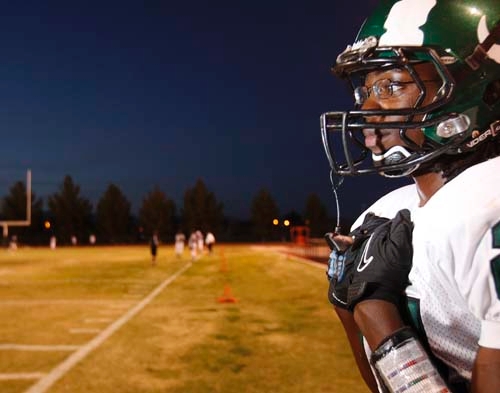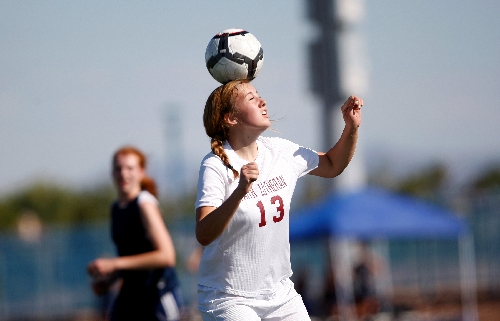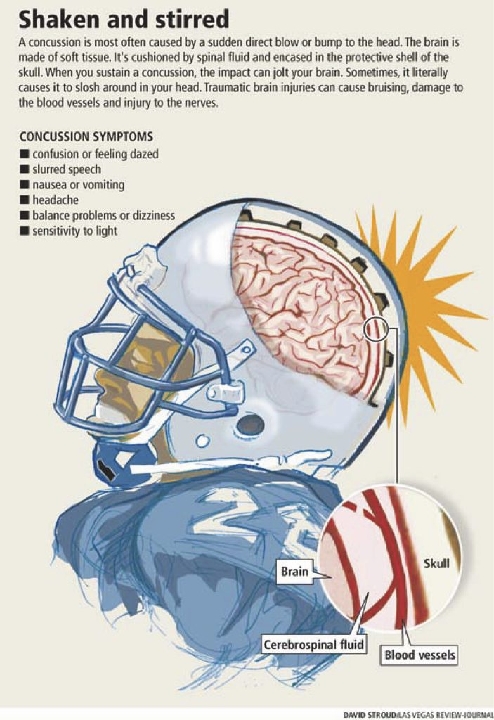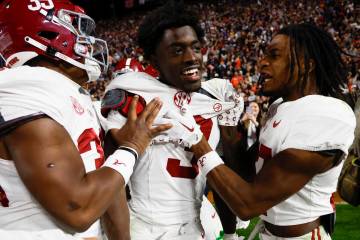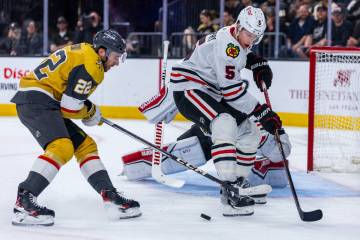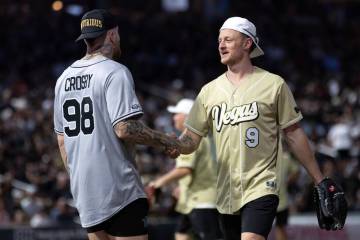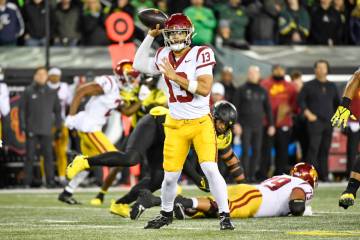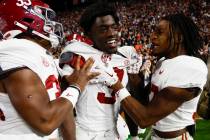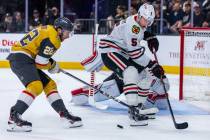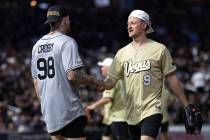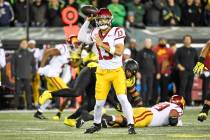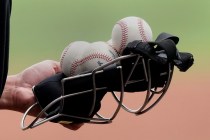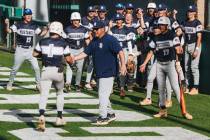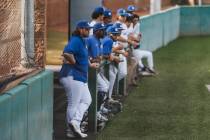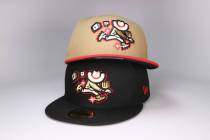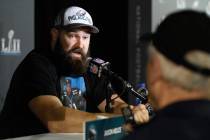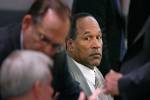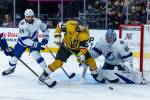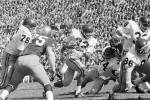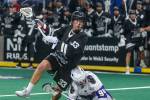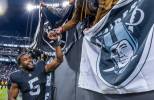Athletes make headway after concussions
Shamel David has emerged as one of Southern Nevada's most prolific running backs this football season.
The first two games of the fall, however, the Rancho High School senior watched his teammates from the sidelines as he recovered from a concussion.
"I can't even explain how much I wanted to come back," David said.
After suffering his concussion with a hit that knocked off his helmet in a three-team scrimmage Aug. 21, David used rest to recover under the watchful eye of his mother, Patricia.
To return to the field, Shamel David had to satisfy the Clark County School District's extensive head injury management procedure, which was established in August 2008.
Both a medical doctor and an athletic trainer eventually cleared David, who has responded to rush for 745 yards and seven touchdowns in five games for the Rams. The Rams' record is 3-4.
David said he was frustrated to sit out, but in hindsight, he understands why he was sidelined.
"I didn't think it was that bad, but I guess for my well being, I had to take two games off," David said. "It's paid off."
David is an example of how an athlete can recover from a concussion if handled properly. Today, coaches and athletes at the college and high school levels are more aware than ever of concussions.
But the causes and symptoms of concussions vary widely, as does recovery time. Local athletes, coaches, athletic trainers and medical personnel have made significant strides in recent years to keep up with the evolving science around the enigmatic injuries.
High school procedures thorough
The tough-guy image is woven into the fabric of football. Players who fight through injuries are admired by fans and highlighted by media, and massive hits and collisions are celebrated in television segments such as ESPN's "Jacked Up."
But the NFL and its teams finally have made concussion management a priority, and awareness has trickled down to the high school level.
"The old smelling salts and 'hold up two fingers' -- that doesn't fly anymore," said Eddie Bonine, executive director of the Nevada Interscholastic Activities Association, the state's governing body for high school sports. "There are a lot of guys suffering from post-concussion syndrome who thought you weren't a real man if you didn't stay out there."
The school district's procedure issued in August 2008 expanded rules for head injury management that were already in place. The procedure states that an athlete who has suffered a concussion cannot return to practice or competition until having clearance from a physician, an approved score on a computerized neurocognitive test called ImPACT and three consecutive days of directly supervised physical exertion under a licensed athletic trainer. The physical exertion consists mostly of running at gradually faster speeds.
The procedure also calls for a 10-day follow-up by the athletic trainer upon the athlete's return to practices or games. If the athlete still shows signs of a concussion -- including symptoms such as headaches, dizziness or problems with vision and memory -- the process starts over.
"There are as many as five different medical professionals involved in that process," said Jim Porter, who serves as Cimarron-Memorial High School's athletic trainer and Select Physical Therapy's area medicine coordinator. "(The procedure) has safeguards to make sure we're doing everything we can do that when they come back, they're not more prone" to further, serious injuries.
Select Physical Therapy has an agreement to provide athletic trainers to Clark County School District high schools. The first partnership was formed with HealthSouth and Sunrise Hospital and Medical Center in 1998, when Porter said "the corner was turned" toward managing the injuries.
Before 1998, there were no more than seven athletic trainers working at area high schools, Porter said. Today, every district high school except Indian Springs has an athletic trainer on staff. Indian Springs has an emergency medical technician on its teaching staff as an athletic trainer.
Porter said the athletic trainers provided by Select Physical Therapy are available to all sports after school ends. Some are already on campus working as teachers.
Porter said it is "always tough" to be on site with every sport. For example, a soccer team could be playing a road match while the football team is practicing on its own campus.
"If I'm at soccer and a kid gets hurt in the gym, I have to do catch-up," he said. "It would be nice if we were like UNLV, where every team has a trainer. We have to do the best that we can."
Testing plays key role
Schools around the country have begun using the ImPACT assessment to help gauge an athlete's recovery from a concussion. Clark County athletic trainers said the test is invaluable.
"You can watch the swelling from a sprained ankle go down," Palo Verde athletic trainer Nicole Paskvan said. "With a concussion, it's not like you can throw an ice pack on the brain and watch the swelling go down."
Freshmen athletes in the school district are charged a $5 fee to take the test. The initial exam is called a "baseline test" because results are compared to a later test the athlete takes after they have suffered a concussion.
The test consists of six components: word memory, design memory, X's and O's matching, matching shapes to numbers, matching colors and counting backwards from 25 to 1 while remembering letters.
Last month, the House voted to set federal guidelines for managing concussions with student athletes. The bill, known as the Concussion Treatment and Care Tools Act, will require the government to organize a conference within two years for medical and athletic officials to set the guidelines.
However, Porter said the recent development is unlikely to affect the school district because it already has an extensive concussions policy in place.
The NIAA has had a concussion management procedure since 2003. In August, the NIAA adopted National Federation of High Schools guidelines on concussions similar to its original policy, which has authority over nondistrict high schools such as Bishop Gorman and Faith Lutheran.
Bonine said all Nevada sports referees are mandated to watch a national federation video. If an athlete shows signs of a concussion, the official has the right to direct their removal from the game.
A medical doctor, doctor of osteopathy, physician's assistant, advanced registered nurse practitioner, licensed athletic trainer, paramedic or school nurse can then make an on-site determination that the athlete indeed has a concussion.
All it takes is one such professional to diagnose a concussion, though only a medical doctor or doctor of osteopathy can authorize the athlete's return.
"We're ahead of the curve," Bonine said. "The national federation is just now implementing recommendations we've had for years."
Not without dispute
Controversy erupted around the rules in 2007, when Canyon Springs quarterback DeVonte Christopher wasn't allowed to return to a Sunrise Region semifinal playoff game against Del Sol for most of the second half. Christopher was slammed to the turf on a sack during the third quarter.
Christopher appeared shaken after standing up, which led referee Chris Bibbins to prevent him from returning to the game. Del Sol rallied to win, 28-24.
Christopher, now a sophomore receiver at Utah, recently said he does not believe he suffered a concussion.
"It was tough to sit on the sidelines and not be able to play because of someone's decision," he said. "I just feel like that game was kind of taken away from us."
Christopher appreciates that concussion awareness is increasing, and he doesn't have a problem with ruling athletes out who have been diagnosed with a concussion by a medical doctor. However, he takes issue with the idea that referees should have the power to direct a player's removal from a game.
"I don't think it should be the ref's decision," he said.
UNLV ahead of curve
Like local high schools, UNLV has been proactive in dealing with concussions.
In April, the NCAA Executive Committee adopted a policy requiring schools to have a concussion management plan that required the removal of an athlete who showed any signs of a concussion in practice or an event.
UNLV, meanwhile, is in its fourth year of administering a neurocognitive test to its athletes similar to the one used in local high schools, said Kyle Wilson, UNLV's director of athletics training.
"One of the big problems is, if someone has a head injury, you can't see that," Wilson said. "That's why we've incorporated some of the 'baseline' testing."
Wilson said UNLV also followed an NCAA mandate this year to give a presentation on concussions to its athletes.
In 2008, UNLV wide receiver Phillip Payne sat out a week after suffering a minor concussion against Brigham Young. He returned against New Mexico on Nov. 8, but suffered a season-ending concussion in that game.
"I just blacked out," said Payne, now a junior. "That knocked me out completely."
While on the ground, Payne later learned, former Rebels teammate Frank Summers had been in his face asking whether he could get up.
"I don't even remember seeing him," Payne said.
Payne never had dealt with a serious injury before his concussions in 2008. He credited UNLV's athletics training staff with helping him recover and eventually get back on the field.
The strategy of complete rest paid off for Payne, who bounced back to catch 58 passes for 661 yards and seven touchdowns as a sophomore.
"I got a lot of sleep and was off my feet," Payne said. "I had no physical activity at all."
Payne, now a standout junior, was the Rebels' leading receiver entering Saturday's game at West Virginia. He was suspended for the game after reportedly making comments critical of UNLV's coaching staff on Twitter.
Wilson said the football program experiences the most concussions at UNLV, followed by both soccer teams.
Concussions have not been a major issue at the College of Southern Nevada, which offers only baseball and softball, CSN athletic trainer Steve Jacobucci said.
"In 11 seasons, I can only remember one serious (concussion)," Jacobucci said, referring to a College of Southern Idaho baseball player who had been beaned in the head.
Wilson said awareness of concussions has "dramatically increased" since he started at UNLV in 1984, but researchers are far from knowing everything there is to know about the injuries.
"We're just at the tip of the iceberg of the knowledge people have," he said.
An evolving science
Las Vegas High School football player Edward Gomez died Nov. 23, 2003, two days after he collapsed near the end of a playoff game. An autopsy revealed that Gomez died of blunt head trauma.
Though Gomez wasn't believed to have suffered a concussion, his death intensified the local discussion of safety in contact high school sports.
Months before Gomez's death, Cimarron athletic trainer Porter and neuropsychologist Dr. Tom Kinsora were developing the ImPACT test currently used in the school district.
Kinsora, who runs Sports Concussion Specialists of Nevada with Dr. Staci Ross, said testing is crucial because of how concussion symptoms vary.
"In many cases, an athlete will look OK and deny a symptom, but when we test them cognitively, we can pick up problems with processing speed that you would never be able to pick up talking to them," Kinsora said.
Common symptoms of concussions include headaches, dizziness and vision problems, but Kinsora said the science around the injury is always on the move.
"It's been in the last 10 years or so we've only understood the cascade of metabolic changes that occur. We have better techniques to measure," Kinsora said.
About 11 percent of all injuries reported within the school district are concussions, Porter said, although overall numbers of concussed athletes weren't available. He said football sees the most cases per participant, followed by girls soccer.
Kari Moloney has come back from two concussions suffered since eighth grade and is now a junior forward for Faith Lutheran's girls soccer team.
Moloney bounced up from a collision in eighth grade, but knew something was wrong when she was losing sight from the corners of her eyes.
"I would go for headers and my depth perception was off," she said.
Moloney hasn't experienced a concussion since October 2009, but headaches still "come and go."
"It's frightening because they can't tell you whether it's healed or not," said Jan Moloney, Kari's mother. "It's all based on symptoms, and symptoms depend on other things."
It's the reason David said an athlete in a contact sport has to trudge on after returning, in his case from a continuous headache and fatigue in the sun.
"If you go in there with the mentality of, 'I don't want to get hit, I might get injured,' you're not going to be effective," he said. "You've just got to be aggressive."
rest and recovery
A University at Buffalo study published in January reported that a program of progressive exercise on a case-to-case basis can help relieve symptoms of post-concussion syndrome.
But the most widely prescribed method of recovery is plain and simple rest.
"The general rule is to really avoid mental or physical exertion that exacerbates symptoms, then gradually kind of resuming the activities," Ross said. "Sometimes, they're off school."
Concussions can sideline an athlete for days, weeks, months or longer, though Ross said "a good rule would be to expect at least a week off."
The injuries contributed to the retirements of Hall of Fame quarterbacks Troy Aikman, Steve Young and others. Safety upgrades to helmets have helped prevent concussions, but there appears to be a long way to go.
Dr. Michael Milligan, medical director and head team physician at the University of Nevada, Las Vegas, said it's difficult to design protective equipment that can keep up with the growing size and speed of athletes.
"Those things (with helmets) are helping," Milligan said. "At the same time, athletes are getting bigger and stronger, so that might offset some of it."
Palo Verde football coach Darwin Rost said high school coaches, athletes and parents have no choice but to acknowledge concussions as a serious issue based on the way awareness continues to rise in the NFL.
"When you see guys getting knocked out and it ends their careers, it trickles down to high school,'' Rost said.
Porter said awareness has improved among parents, but he faces occasional battles from parents who believe their child shouldn't need multiple medical opinions to return to play.
He said he points to Pittsburgh Steelers quarterback Ben Roethlisberger as an example of how concussions should be taken more seriously. Roethlisberger went only two weeks between playing games in November after suffering the fourth concussion of his career.
"If you're Ben Roethlisberger, they held him out for 14 days last year," Porter said. "Is not your son or daughter more valuable?"
One parent taking the issue seriously is Patricia David, who is glad the current system requires multiple medical opinions before an athlete, such as her son Shamel, can return to play.
"Concussions need to be taken seriously," she said. "It's an aggressive game. When athletes get hurt, we need to make sure it's not taken lightly."
Contact reporter Tristan Aird at taird@reviewjournal.com or 702-387-5203.
SYMPTOMS HARD TO DETECT
Most injuries in football, soccer or other contact sports are easy to spot with the casual eye. An athlete might pull up holding a hamstring muscle or limp off the field with a sprained ankle.
That’s not the case with a concussion, which is a brain injury that occurs most often with a collision involving the head. The injury can have no visual symptoms, but make no mistake, it causes a wide range of problems internally.
“With a concussion, the brain is shaken violently,” said Dr. Tom Kinsora, a neuropsychologist who operates Sports Concussion Specialists of Nevada with Dr. Staci Ross. “That shaking causes a cascade of metabolic changes in the brain. The brain isn’t bruised in a concussion, but what changes (are) the neurotransmitters.
“What you end up with is a rapid change in the cells’ chemical makeup. Some of the chemicals will get flushed out of the cell; others get flushed into the cell. This ends up causing a disruption of how the brain cells communicate with each other.”
Jim Porter, who works with concussions as Cimarron-Memorial High School’s athletic trainer and Select Physical Therapy’s area medicine coordinator, said concussions can be caused by a direct blow to the head or something less noticeable.
“The skull is like a hard, rigid case that encases the brain,” he said. “Any time the brain rotates or is stirred, it can cause a concussion.”
Kinsora said the severity of a concussion usually depends on the speed and angle at which the collision occurs. He added the system of “grading” concussions on a three-scale level of severity is outdated.
“A lot of research has determined that (grading) is an overly simplistic way of looking at concussions,” he said. “Significant concussions can occur without being knocked out.”
Kinsora said that common symptoms of concussions include headaches, nausea, problems with memory and vision, balance problems, dizziness and fatigue.
TRISTAN AIRD/LAS VEGAS REVIEW-JOURNAL



